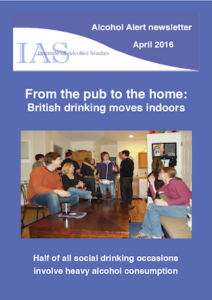In this month’s alert
Editorial – April 2016
Welcome to the April 2016 edition of Alcohol Alert, the Institute of Alcohol Studies newsletter, covering the latest updates on UK alcohol policy matters.
In this issue, a University of Sheffield study finds that heavy drinking at home is increasingly common among Brits, while health experts predict a rise in deaths resulting from cuts in alcohol duty in recent years. Other articles include: 9 out of 10 people fail to link alcohol with cancer, as HMRC reforms aim to minimise duty fraud, and Emergency service leaders call for a lower drink-drive limit as House of Lords peers pass drink-driving bill through report stage.
Please click on the article titles to read them. We hope you enjoy this edition.
Heavy drinking at home now typical feature of British life
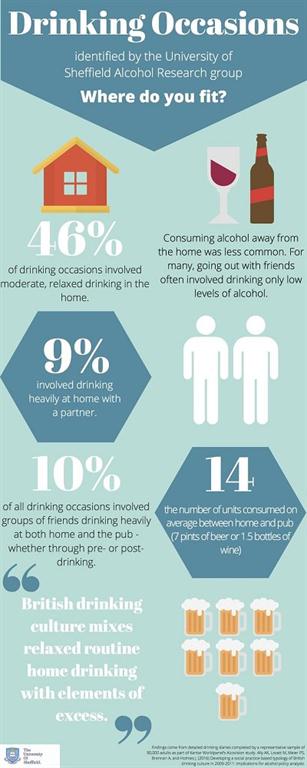
University study finds half of all social drinking occasions in the home involve heavy alcohol consumption
Researchers from the University of Sheffield have found that ‘pre-drinking’ is a common feature of nights out, and that events which take place exclusively at home – such as dinner parties – involved increased or “higher risk drinking”.
These findings imply that thanks to the availability of cheap alcohol in off-licences premises such as supermarkets, the concept of a heavy episodic pre-drinking routine is embedded among particular British drinking cultures.
The study, published online in the scientific journal <ahref=”http: onlinelibrary.wiley.=”” com=”” journal=”” 10.=”” 1111=”” %28issn%291360-0443″=””>Addiction</ahref=”http:> and funded by Alcohol Research UK, looked at detailed drinking diaries completed by a nationally-representative sample of 60,215 adults as part of Kantar Worldpanel’s Alcovision study. In addition to recording how much they drank, participants detailed where and when they consumed alcohol, who was there and why they were drinking, over a seven-day period.
Researchers based at the University of Sheffield’s School of Health and Related Research (ScHARR) then used those diaries to identify eight main types of drinking occasion.
The results showed that between 2009 and 2011, most drinking occasions in the UK involved drinking in the home, including:
-
- Drinking at home alone (13.6% of occasions)
-
- Light drinking at home with family (12.8%)
-
- Light drinking at home with a partner (19.6%)
-
- Heavy drinking at home with a partner (9.4%)
Consuming alcohol away from home was less common and included going out for a few drinks with friends (11.1% of occasions) and going out for a meal as a couple or with family (8.6%). The study also found that 10.4% of occasions involved groups of friends moving between home and pub drinking (mixed location heavy drinking) and consuming on average 14 units of alcohol – the equivalent of seven pints of beer or one and a half bottles of wine.
In comparison, almost half of get-togethers with friends or family which take place exclusively at home, such as dinner parties, house parties and watching sport, involved increased or higher risk drinking.

Dr John Holmes, a senior research fellow of the University of Sheffield’s Alcohol Research Group (SARG), and co-author of the study, said: “Far from the stereotypes of binge Britain or a nation of pub-drinkers, we find that British drinking culture mixes relaxed routine home drinking with elements of excess.
“Young people do binge drink on big nights out but we also see heavy drinking among middle-aged couples relaxing at home and among all ages at domestic get-togethers.”
The study defined low risk drinking as consuming fewer than six units for women or eight units for men during the occasion. Increasing risk drinking was defined as consuming 6–12 units (women) and 8–16 units (men) and high risk drinking involve drinking more than 12 units for women and more than 16 units for men. These thresholds are based on a commonly used definition of binge drinking which is 6 units for women and 8 units for men. A unit is approximately 8g or 10ml of pure alcohol. There are approximately two units in a pint of normal strength beer, one unit in a shot of spirits and two units in a 175ml glass of medium-strength wine.
Dr James Nicholls, director of research and policy development at Alcohol Research UK, said “The idea that there is a single British drinking culture is wrong. Drinking behaviours have changed enormously over time, and there are wide variations within society.
“Rather than assuming society is neatly divided between ‘binge’, ‘heavy’ or ‘moderate’ drinkers we should think about the occasions on which people drink more or less heavily – and the fact we may be moderate in some contexts, and less so in others. If we want to address problems associated with drinking, we need to recognise the diversity of how we drink and understand the crucial role that cultures and contexts play in that.”
Katherine Brown, director of the Institute of Alcohol Studies said:
“Two thirds of all alcohol sold in the UK is bought from shops and supermarkets, which is a big change from the traditional British pub culture. The fact it is so much cheaper to drink at home is a huge driver for this shift, which is why tackling cheap supermarket drink would help pubs and also improve the nation’s health.
“The increased availability of cheap alcohol means frequent home drinking is more commonplace, including drinking at home before heading out to a pub or restaurant. This makes it very easy to exceed the low risk drinking guidelines recommended by our Chief Medical Officers, which raises risks of cancer, heart disease and liver cirrhosis. It’s important that consumers are aware of how many units are in their drinks and how alcohol may affect their health so they can make fully informed decisions about their drinking. Having clear labels on alcohol products with independent health information would be a sensible first step in supporting drinkers to make healthier choices, alongside mass media campaigns.”
‘Developing a social practice-based typology of British drinking culture in 2009-2011: Implications for alcohol policy analysis‘ is published as an open access paper in the scientific journal <ahref=”http: onlinelibrary.wiley.=”” com=”” journal=”” 10.=”” 1111=”” %28issn%291360-0443″=””>Addiction. Listen to Dr John Holmes explain the paper’s findings in our Alcohol Alert podcast.</ahref=”http:>
Alcohol duty cuts will cause increase in deaths, warn health experts
Nick Sheron and Ian Gilmore predict that the changes to fiscal policy could see mortality increase once more
There will be a “relentless rise” in alcohol-related deaths due to cuts in alcohol duty, warn leading health experts in the British Medical Journal (BMJ).
Meanwhile, the number of alcohol-related deaths will likely continue to decrease in Scotland if legislation on minimum unit pricing for alcoholic drinks is implemented.
Dr Sheron and Professor Sir Gilmore’s predictions are based on an analysis of trends in alcohol-related harm in the context of changes in the alcohol marketplace, in turn driven by changes in fiscal policy, which show that alcohol-related deaths are related to the level of taxation.
History
There was a threefold increase in the number of alcohol-related deaths between 1980 and 2008 in England and Wales, “probably driven by the increased affordability and availability of strong alcohol,” they say.
As wages increased and alcohol taxation was reduced, by 2008 it was possible to buy almost four bottles of vodka for the price of one bottle in 1980. They note that those four bottles represent the weekly alcohol consumption of an average patient with alcohol-related liver cirrhosis.
In the UK, alcohol sales increased from around 400 million litres in the early 1980s, peaking at 567 million litres in 2008. During this time, alcohol-related deaths in England and Wales tripled from 2,314 in 1980, to 7,312 in 2008, with most deaths being liver-related.
Experts say if this trend in rising alcohol prices had continued since 2008, there would have been 11,400 deaths a year by 2030 and a total of 150,000 deaths from 2016 others.
But alcohol-related deaths peaked in 2008, and if current patterns continue there may be around 50,000 fewer deaths than expected.
This was largely due to the introduction of the alcohol duty escalator, which raised duty for alcoholic beverages 2% above inflation every year. Sheron and Gilmore write: “From 2007–08 onwards, the affordability of wine fell by 54%, spirits 50%, cider 27%, and beer 22%, whereas household incomes fell by only 9.5%, suggesting that of the various economic factors influencing alcohol consumption, the 2% duty escalator had the greatest effect [on the affordability of alcohol].”
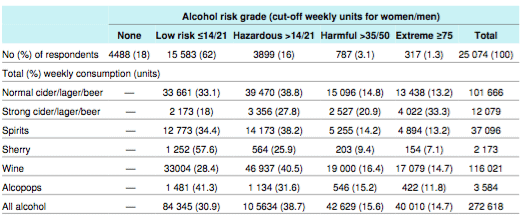
However, a following a “fierce campaign of lobbying” by the Wine and Spirits Trade Association, the duty escalator was dropped in 2014. Furthermore, as incomes begin to rise again (and duty on spirits and cheap cider cut by a further 2% in 2014), the authors predict that there will be a “relentless rise” in alcohol deaths in England once more.
The health of the 20%
The authors observed that the “population consumption theory” goes some way to explaining how the drinks industry profits from the link between consumption and harm.
Sheron and Gilmore find the “Pareto principle” applies to consumption data from the 2011–13 Health Surveys for England (illustrated); 20% of the heaviest consumers drink around 80% of all alcohol purchased.
Harmful and extreme drinkers comprise a tiny minority, 4.4% population, but consume one-third of all alcohol sold. The combination of hazardous, harmful, and extreme drinkers provides almost 70% of drinks industry sales by volume.
The drinks industry uses its influence on government to protect this market, say the authors, warning that the lives of the very consumers upon whom the drinks industry profits will suffer most if their warnings are not acted upon in future.
IAS blog – Alcohol and pregnancy: understanding of uncertainty and precaution from a cross-cultural perspective
 In January 2016 the UK Chief Medical Officer (CMO) published new recommendations on drinking guidelines, which advised that pregnant women should avoid alcohol altogether. But what can we learn from other countries that have endorsed such a recommendation?
In January 2016 the UK Chief Medical Officer (CMO) published new recommendations on drinking guidelines, which advised that pregnant women should avoid alcohol altogether. But what can we learn from other countries that have endorsed such a recommendation?
Since the first diagnosis of Foetal Alcohol Syndrome (FAS) in the 1970s we have learned a lot about the harmful effects of alcohol exposure in pregnancy. High levels of drinking have been associated with adverse outcomes in pregnancy as well as in development and health of the foetus. However, there is no clear evidence of harm following drinking at low to moderate levels. As yet, no safe limit has been established.
The lack of clear evidence for harm resulting from low levels of drinking in pregnancy has been reflected in the National Institute for Health and Care Excellence (NICE) guidelines in England. These guidelines stated that women should try to avoid drinking alcohol during pregnancy and if they chose to drink they should not exceed one to two units once or twice per week after the first trimester. The absence of a definite threshold under which drinking could be regarded as safe, has led many other countries to adopt the cautious public health approach stipulating that pregnant women should not drink at all. This was also the case in the Chief Medical Officers’ (CMO) recommendations in January 2016, which were welcomed by NICE.
Up until January this year, it appeared England, in contrast to countries endorsing abstinence, interpreted the same body of evidence differently. This intrigued me to investigate this further. As I am Swedish myself, it made sense to explore the topic from the Swedish as well as English context, and I decided to compare these two countries within my PhD research. At the time of my research, pregnant women in Sweden were advised to abstain from alcohol, whereas the English NICE guidelines suggested women could have small amounts if they chose to. The different policies, along with lower overall drinking levels in Sweden than the UK and lower prevalence of drinking in pregnancy (Swedish examples here and here), provided an interesting base for comparison.
The findings from my study tallied with previous research on alcohol and pregnancy. In a survey I conducted with 347 parents in England and Sweden, only 6% of Swedish women reported any alcohol use when they were pregnant in contrast to 44% of English women. So why is this? In the survey, women were asked if they believed that there is a safe limit of drinking in pregnancy, to which 37% of English women answered “yes” compared to only 5% of Swedish women.
Advice from health care professionals may play a part in shaping views around safe limits of drinking. In fact, 32% of English women in my study had been advised to reduce their drinking, compared with only 2% of Swedish women. In addition, 23% of English women reported that they had been told that small amounts were acceptable to consume, again significantly higher than Swedish women, among whom only 2% reported they had received such advice. This was further emphasised in interviews I conducted with parents, as the advice from midwives in Sweden was consistently described as favouring abstinence while English parents had varied experience of the advice given. This ranged from abstinence to limit intake to smaller amounts. A few women even described hearing conflicting advice from different health professionals.
In my study I also interviewed midwives in both countries, who all said they advise women to abstain. What emerged however, was a discord between personal and professional opinions on the matter of harm from drinking small amounts of alcohol. While Swedish midwives firmly believed that small amounts could be harmful to the baby, English midwives referred to the uncertainty in the evidence base and as one midwife argued: “in the back of your mind you go ‘one’s not gonna kill you’ but I prefer to say no, no drinking”. Research from other countries that endorse abstinence policy, such as Australia and the Netherlands, has shown that midwives are not entirely convinced that small amounts of alcohol are harmful. Some advise that occasional drinking is acceptable.
If we really want to unpick these differences, we may need to look at social norms and the underlying moral narratives. During interviews with parents I noted that Swedish parents were more likely to describe drinking in pregnancy as risky at any level. Their perceptions of prenatal alcohol use as an issue focused on the vulnerability of the foetus and women’s responsibility as a mother-to-be to ensure that the safety of the baby. English parents on the other hand emphasised their belief that women need to take care of themselves as well as their baby, accomplished either by abstaining or keeping alcohol use to what they perceived was a sensible or safe limit. These narratives stressed that women need to be viewed as autonomous individuals, capable of making informed decisions regarding alcohol. As one woman put it: “I don’t think that it helps women to be public property, when they are pregnant. To disengage their own brains”.
Alcohol use in pregnancy can certainly have detrimental, irreversible outcomes and we should continue to work to prevent these. What I think is important from a public health perspective is to gain a greater understanding about how women interpret the information surrounding the guidelines, and how they translate that information into behaviour. In short, I think we need to further explore the role of social norms and perceptions around safe levels of drinking for shaping our health communication of the new CMO guidelines.
Written by Lisa Schölin, Final year PhD student at the Centre for Public Health at Liverpool John Moores University and Research Assistant in Alcohol Policy at Institute for Social Marketing, University of Stirling for the IAS Blogs section of our website (view here).
Changing the environment? Nudging pubs and zero alcohol awards
From Alcohol Policy UK
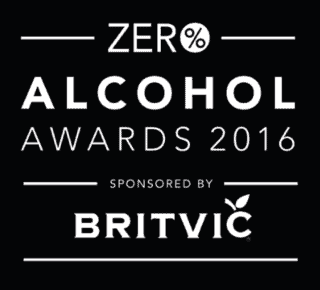 Two initiatives encouraging products and places that support those who want to drink less or abstain have plans to develop further. As non-industry led projects, they raise interesting questions over the role and scope of influencing drinking environments.
Two initiatives encouraging products and places that support those who want to drink less or abstain have plans to develop further. As non-industry led projects, they raise interesting questions over the role and scope of influencing drinking environments.
Zero alcohol awards
Alcohol Concern recently concluded its first ‘Zero Alcohol Awards’ programme to recognise and reward the range of zero-alcohol drinks provided by retailers, bars and pubs across the country. Sponsored by Britvic, it also aimed to recognise innovators bringing new products to the market and creating new environments to enjoy them in.
Alcohol Concern say a growing number of people are choosing to be alcohol-free; one-in-five adults (one-in-three in London) do not drink alcohol at all and the number of young people aged 16–25 choosing not to drink has increased by 40% over the last decade. As such the awards aimed to capitalise on the positive trend of consumers choosing a non or low alcohol lifestyle.
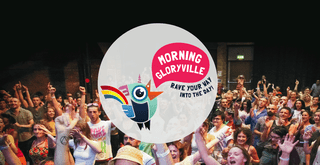 Thirty-eight companies, venues and enterprises were considered for 8 awards judged by a mix of stakeholders, including Dry January participants who were asked to nominate their favourites for the People’s Choice category awards. Winners included All Bar One, whose non-alcoholic drinks reportedly now outsell alcoholic drinks, and Morning Gloryville, a ‘sober morning dance party’.
Thirty-eight companies, venues and enterprises were considered for 8 awards judged by a mix of stakeholders, including Dry January participants who were asked to nominate their favourites for the People’s Choice category awards. Winners included All Bar One, whose non-alcoholic drinks reportedly now outsell alcoholic drinks, and Morning Gloryville, a ‘sober morning dance party’.
Alcohol Concern are planning to further develop the awards next year and are investigating a localised version of the awards for Local Authorities and community groups.
‘Nudging pubs’
A report exploring how pubs can improve their offer to customers who want to drink less or no alcohol has been released by Club Soda, an organisation that supports individuals who want to change their drinking.
Developed in conjunction with a London local authority and Alcohol Concern, the report makes a number of recommendations relating to opportunities to improve the practice of pubs and bars for more temperate customers. It recommends promoting the business case for venues to improve their offer to their non-drinking customers, which it says will bring gains that build on lower consumption trends and increased demand for new soft drinks and lower and non-alcoholic beers.
Sharing ideas and promoting best practice, for example through a self-assessment process and award scheme for venues including the trade and drinks industry, is also recommended. The report also advises articulating a clear understanding of expectations from industry and local authorities, and demonstrating what ‘good’ looks like. It says ‘rewarding success’ will add a further incentive for venues, potentially at local and national level.
Club Soda also highlights the relevance of the project in capitalising on recent downward trends in consumption, with research indicating over five million adults in the UK who have tried to cut down, and still want to reduce their drinking.
More nudging needed?
Such initiatives may prompt local areas to consider whether they should be doing more to support or encourage environments that may ‘nudge’ people towards drinking less – or indeed improve the experience of those who do not wish to drink at all in licensed venues.
Sections of the industry may argue they are already busy in this regard – last year the BBPA highlighted a range of ‘responsible’ retailing practices being undertaken by the pub and brewing sector, although very limited evaluation supports many of the initiatives. Questions over the impact of the now ceased responsibility deal were also subject to debate, whilst a further focus on ‘partnership’ activity has been championed lately, and embraced by the Home Office’s recent crime strategy.
Public health advocates or course highlight the importance of ‘multi-component’ approaches that include key action on price, availability and marketing. Whether the Licensing Act is fit for purpose will continue to be debated, but many would argue that beyond the scope of legislative changes, ‘nudging’ may have only a limited role to play. How much of this falls to statutory agencies, or retailers themselves may not be a straightforward issue. Shaping the drinking environment may be as important as it is complex.
9 out of 10 people don’t link alcohol with cancer
Almost 90% of people in England don’t associate drinking alcohol with an increased risk of cancer, according to a new report (1 April)
A study commissioned by Cancer Research UK and led by researchers from the University of Sheffield has found that just 13% of adults mentioned cancer when asked “which, if any, health conditions can result from drinking too much alcohol?”
Drinking alcohol is linked to an increased risk of seven different cancers – liver, breast, bowel, mouth, throat, oesophageal (food pipe), laryngeal (voice box) – but the survey highlighted a lack of understanding of the link between drinking alcohol and certain types of the disease.
When prompted by asking about seven different cancer types, 80% said they thought alcohol caused liver cancer but only 18% were aware of the link with breast cancer. In contrast alcohol causes 3,200 breast cancer cases each year compared to 400 cases of liver cancer.
The study also showed that only one in five people could correctly identify the previous recommended maximum number of units that should not be exceeded in a day, as recommended at that time in 2015.
Among drinkers, as few as one in 10 men (10.8%) and one in seven women (15.2%) correctly identified these recommended limits and used them to track their drinking habits.
The findings are based on a nationally representative online survey of 2,100 people conducted in July 2015.
The report, produced by researchers at the University’s School of Health and Related Research (ScHARR), came as a consultation on how well new drinking guidelines proposed earlier this year are communicated drew to a close. The guidelines drew attention to the link between alcohol and cancer, and highlighted the need for greater public awareness of this risk.
Dr Penny Buykx, a senior research fellow at The University of Sheffield and lead-author of the report, said: “We’ve shown that public awareness of the increased cancer risk from drinking alcohol remains worryingly low.
“People link drinking and liver cancer, but most still don’t realise that cancers including breast cancer, mouth and throat cancers and bowel cancer are also linked with alcohol, and that risks for some cancers go up even by drinking a small amount.”
Alison Cox, Cancer Research UK’s director of cancer prevention, said: “The link between alcohol and cancer is now well established, and it’s not just heavy drinkers who are at risk. This is reflected in the new guidelines issued by the UK’s Chief Medical Officers that stated that the risk of developing a range of illnesses, including cancer, increased with any amount of alcohol you drink.
“As the consultation closes on how clear and understandable the new guidelines are, it’s concerning that so few people know that alcohol increases the risk of seven types of cancer. If the new guidelines are to make a difference and change drinking habits in the UK national health campaigns are needed to provide clear information about the health risks of drinking alcohol.”
Call for written evidence on the relationship between alcohol-related harm and employment in the over 50s
Submissions requested for future inquiry (4 April)
The Drink Wise Age Well partnership of leading national alcohol and ageing charities have launched an inquiry, led by the International Longevity Centre – UK (ILC-UK) into alcohol-related harm amongst the over 50s.
Each year the partnership will hold an independent inquiry on a key theme pertaining to alcohol and the over 50s. Baroness Sally Greengross will chair the inquiry’s evidence sessions, sponsored by the Big Lottery Fund.
The focus for 2016 is employment; early findings from the Drink Wise Age Well survey show that of those surveyed whose alcohol use has increased, 40% cite retirement and 20% loss of purpose for their increased consumption.
The 2016 inquiry will focus on three key areas: alcohol and over 50s seeking employment; the second will examine alcohol and over 50s currently in employment; and the third will focus on alcohol and over 50s transitioning to, or currently in, retirement.
The written submissions will form a key part of the evidence base for the next annual State of the Nation report
The deadline for submissions is Wednesday 1st June 2016. For more information, visit the ILC website.
Alcohol taxes would have to rise 28% to match minimum unit pricing in Scotland
Sheffield uni modelling tackles key question behind long-running MUP court case (8 April)
A new report from the Sheffield Alcohol Research Group (SARG), commissioned by the Scottish Government, estimates that alcohol taxes would have to rise by 28% in order to achieve comparable reductions in alcohol-related deaths to a 50p minimum unit price (MUP). Moreover, the report shows that such an increase in taxes would be a less targeted measure, raising the cost of alcohol for ‘moderate’ consumers by more than MUP.
The analysis addresses a key question at the heart of the ongoing legal challenge to the Scottish Government’s efforts to introduce MUP. In December, the European Court of Justice returned the case to the Scottish courts, tasking them with determining whether alternative measures to MUP, particularly alcohol taxes, can protect human life and health as effectively with less restriction of trade. The SARG report suggests that achieving the same ends through alcohol taxes would require dramatic and unprecedented rises – duty increases have rarely exceeded 5% in the past twenty years.
Using the influential Sheffield Alcohol Policy Model, the researchers suggest that a 50p minimum unit price would reduce alcohol-related deaths and hospital admissions by 7%. Moreover, it would do so at minimal cost to ‘moderate’ drinkers (those drinking below the previous low-risk drinking guidelines of 21 units a week for men, and 14 units a week for women). According to the model, MUP will have little effect on moderate drinkers, who will pay just £2 (0.5%) more and drink only four fewer units (1.2%) a year.
By contrast, the 28% increase in tax necessary to achieve similar gains for health would have a much more significant impact on moderate drinkers, who would spend £17 a year (4.4%) more and drink eight units a year fewer (2.6%). Moreover, tax increases would impose a much greater financial burden on hazardous and harmful drinkers (many of whom are already in poverty) to avert the same number of deaths. For example, harmful drinkers would pay £152 more each year under a 28% increase, compared to just £6 more under MUP.
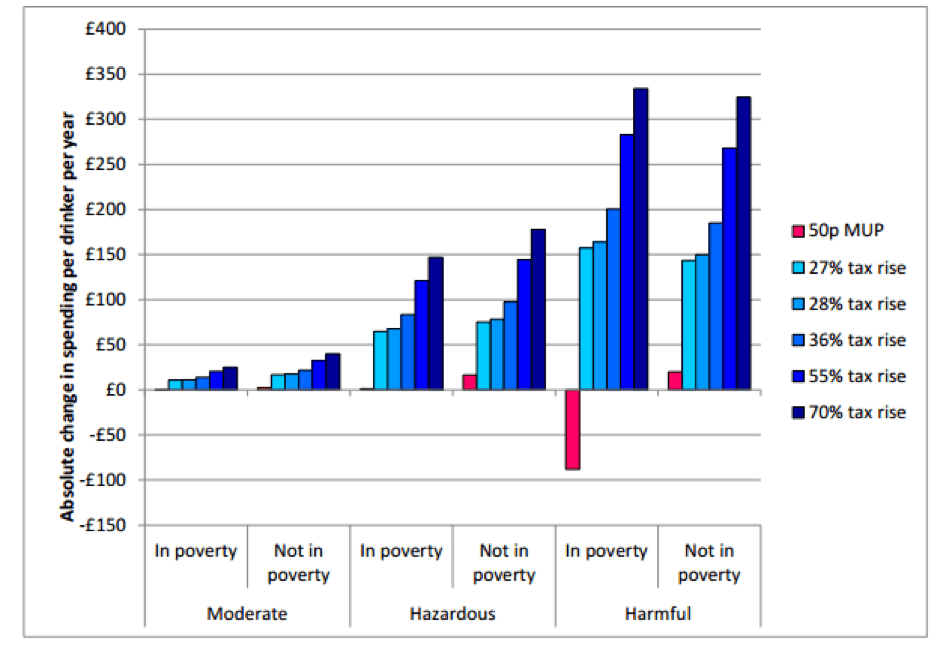
The report also found that MUP would do more than tax increases to reduce health inequalities, because it is more targeted at the cheap alcohol consumed by lower income groups. A 50p MUP would save 56 lives a year of those in poverty, compared to 28 for a 28% tax rise. By contrast, the majority of deaths averted from a tax rise would come from those not in poverty.
The final hearing for the minimum unit price case at the Court of Session in Edinburgh is provisionally scheduled for June.
Download the full report here.
Alcohol to be sold at Scottish motorway services
From Herald Scotland (9 April)
Alcohol is set to be sold at one of Scotland’s busiest motorway service areas for the first time.
The premises licence was granted to the new Marks and Spencer Simply Food at Moto services on the M9 at junction 9 at Bannockburn, where the M9 and M80 meet.
It follows moves to relax a law that used to ban the sale of alcohol at motorway service stations.
Members of Stirling Licensing Board chose to grant approval for the application despite fears about drink being consumed and advertised on the site. Police raised no objections to the plans to sell alcohol between the hours of 10am and 10pm at the store. The services have been open since 1985, when the land was handed over to the former Granada Services company by the Secretary of State to create a rest area.
Speaking on behalf of M&S, representative Robert Skinner told the licensing board: “People tend to go to these stores because of the quality of their food… the licence is aimed at complementing that offering.
“Almost all M&S Simply food stores are licensed.”
SNP councillor Gerry McLaughlan said that he had concerns about people drinking at the service station.
He said: “There is a seating area outside in the car park. This is well known as a rest area and I know that people do use it regularly. My fear is that people may purchase drink and then sit outside and have it with their Burger King meal.”
Councillor McLaughlan also said that a large number of football supporters pass through the services and could buy drink from M&S at the services.
A representative from Moto Services said staff did not allow anyone to drink within the area, and that they liaised with police who can recommend if alcohol should not be sold for a period when a big match is taking place.
HMRC reforms to minimise alcohol duty fraud
New alcohol strategy aims top close tax gap by tackling fraud as number of new registration scheme sign-ups falls short of expectations (11 April)
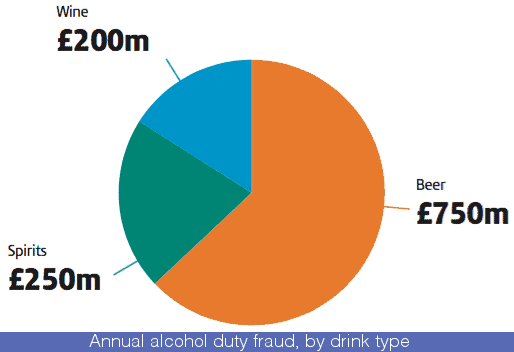 HM Revenue & Customs (HMRC) has launched a strategy aimed at minimising an estimated annual alcohol tax gap worth £1.2 billion.
HM Revenue & Customs (HMRC) has launched a strategy aimed at minimising an estimated annual alcohol tax gap worth £1.2 billion.
‘Modernising alcohol taxes to tackle fraud and reduce burdens on alcohol businesses‘ looks to overcome a gap which represents roughly 8-10% of the annual income generated from alcohol duties (£10 to £10.5 billion) since 2010. To date, HMRC loses £750m worth of beer, £250m spirits, and £200m wine to fraud (illustrated).
According to Damian Hinds, Exchequer Secretary to the Treasury, the new strategy has two aims: “balancing minimising the administrative burdens of paying alcohol duty with continuing to bear down on duty fraud through regulation and enforcement.”
The announcement came as City AM reported that the government’s Alcohol Wholesaler Registration Scheme, introduced in the New Year, received only a quarter of the sign-ups as HMRC had predicted.
The scheme received around 4,800 applications before its deadline of 31 March, although HMRC had previously estimated around 20,000 business might need register and had directly identified 9,500 eligible parties.
“We are currently looking at who applied and will use that analysis to determine what we do next for those who have not applied but should have,” an HMRC spokesperson said.
HMRC has seized 50 million litres of illicit alcohol with a duty value of £106 million and levied penalties of over £84 million in the last five years (illustrated), and losses protected through stricter enforcement exceeded £1 billion last year. However, alcohol fraud remains one of the largest tax frauds the UK faces.
HMRC will consult on reform of procedures for the collection of alcohol duty in summer 2016.
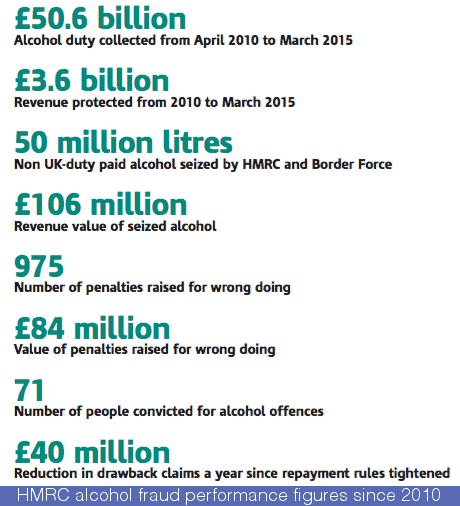
The trouble with drinking guidelines: What, in the world, is a standard drink?
Adapted from Medical News Today (12 April)
According to a new report published by the scientific journal Addiction, the answer to that question varies widely by country, and many countries don’t provide an answer.
Researchers looked at 75 countries that might be expected to provide low-risk drinking guidelines and a definition of a ‘standard drink’. Only 37 countries (under 50%) did so, and their guidelines and ‘standard drink’ definitions were inconsistent.
The size of a standard drink varies by 250%, from a low of 8 g in Iceland and the United Kingdom to a high of 20 g in Austria. An 8 g drink is equivalent to 250 ml (8.45 US fluid ounces) of 4% beer, 76 ml (2.57 oz) of 13% wine, or 25 ml (0.85 oz) of 40% spirits.
In the most conservative countries, low-risk consumption means drinking no more than 10 g of pure ethanol per day for women, 20 g for men, whereas in Chile, the low-risk upper limit is 56 g per day.
In Australia, Grenada, Portugal, and South Africa, low-risk drinking guidelines are the same for women and men. The UK joins that list with its new guidelines.
Co-author of the report Keith Humphreys says, “If you think your country should have a different definition of a standard drink or low-risk drinking… there’s probably another country that agrees with you.”
The World Health Organization (WHO) defines a standard drink as 10 g of pure ethanol, with both men and women advised not to exceed 2 standard drinks per day. Although the WHO’s definition of a standard drink is the one most often used, 50% of countries with drinking guidelines don’t use it.
Responding to the story in The Times newspaper, Katherine Brown, director of the Institute of Alcohol Studies, said: “Many countries established alcohol guidelines at different points in time, based on what data was available to them, so some may be outdated.
“The new UK low-risk drinking guidelines are based on the most up-to-date evidence available.”
Three drinks a day “significantly increases” stomach cancer risk
Cancer charity’s report identifies a probable link with stomach cancer for the first time (21 April)
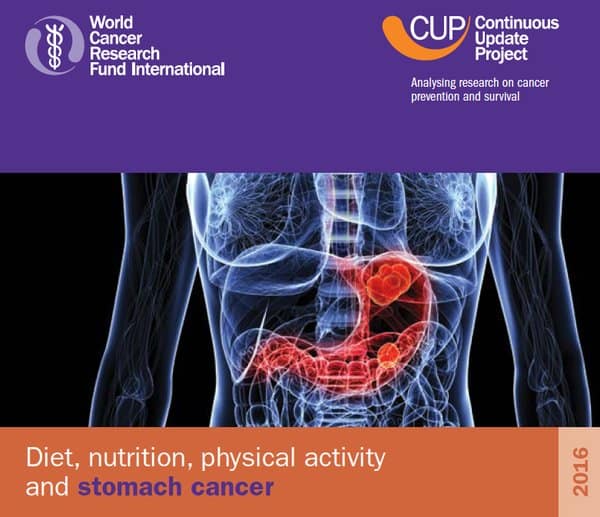 A new report from the World Cancer Research Fund (WCRF) has concluded that drinking alcohol to excess is likely to increase the risk of stomach cancer.
A new report from the World Cancer Research Fund (WCRF) has concluded that drinking alcohol to excess is likely to increase the risk of stomach cancer.
Reviewing 89 studies from around the world and 77,000 cases of stomach cancer, the evidence analysed by WCRF showed that drinking 45 grams of alcohol per day – the equivalent of about three drinks – significantly increases the risk of stomach cancers, and that the risk is most significant in men, as well as smokers and ex-smokers.
The study’s authors also identified “plausible mechanisms in humans”; that is, a set of robust explanations for how alcohol impacts on stomach cancer. For instance, acetaldehyde, the reactive metabolite of alcohol, is carcinogenic to humans. Alcohol also acts as a solvent, enhancing penetration of carcinogens into cells.
These findings come at a time when stomach cancer is the third biggest cancer killer in the world with over 900,000 new cases a year. But whilst alcohol has previously been linked with seven types of cancer – including mouth, throat, bowel and breast cancer – this is the first time that the WCRF have concluded a probable link with stomach cancer.
The WCRF recommends that to protect against cancer, it is best to avoid drinking or limit alcoholic drinks, and follow national guidelines.
News that the WCRF has concluded that drinking alcohol to excess is likely to increase the risk of stomach cancer has led to renewed calls from health experts for health warnings on alcohol product labels.
Responding to the report, Professor Sir Ian Gilmore, Chair of the Alcohol Health Alliance, said: “We were aware that alcohol causes seven types of cancer, and worryingly, this report now demonstrates a link with an eighth – stomach cancer.
“The link between alcohol and cancer is one of the reasons the Chief Medical Officers (CMOs) in the UK revised their alcohol consumption guideline at the beginning of the year. The CMOs recommend that both men and women drink no more than 14 units per week, spread across the week, and that there is no level of drinking which can be considered ‘safe’. This report further demonstrates the need for these new guidelines, and for the public to be informed of the risks of alcohol consumption.
“The public have the right to know about the link between alcohol and cancer, including the link with stomach cancer. The best way to ensure the public has the information they need to make an informed choice about how much they drink is for the Government to mandate health warning levels on all alcoholic products as well as invest in significant mass media campaigns warning of the risks of drinking above the recommended guidelines.”
The report ‘Diet, nutrition, physical activity and stomach cancer‘ contains full details on the findings and conclusions.
Emergency service leaders call for lower drink-drive limit
Open letter sent to Transport Secretary as drink-driving bill passes House of Lords report stage (22 April)
Representatives from the Police, Paramedic and Fire Services have written to the Transport Secretary, Patrick McLoughlin, calling on him to lower the legal drink-drive limit.
The letter coincides with the passing of a bill to lower the drink-drive limit in the House of Lords at the report stage. The Road Traffic Act (Amendment) bill, introduced by Lord Brooke of Alverthorpe, is aimed at lowering the limit from 80mg alcohol per 100ml blood to 50mg/100ml.
The letter is signed by the Police Federation’s Road Policing Lead, Jayne Willetts, the General Secretary of the Fire Brigades Union, Matt Wrack, and the Chair of the College of Paramedics, Andy Newton, who outline the impact of drink-driving on the emergency services, saying:
“Drink-driving places significant pressure on the emergency services, causing thousands of road traffic incidents every year which have to be addressed by police forces, fire services and paramedics. There has been no reduction in drink-driving deaths since 2010, and surveys show that significant numbers of drivers still put themselves, and others, at risk.”
England and Wales have one of the most lenient drink-drive limits in Europe, set at 80mg of alcohol per 100ml of blood. Drivers who drink up to this current limit are six times more likely to die in a car crash compared with drivers who have not drunk. Scotland lowered the limit for drink-driving in 2014 to 50mg/100ml and after nine months rates of drink-driving offences fell by 12%. The only other country with a legal limit as high as the UK’s is Malta, with every other European country setting its limit at 50mg or lower.
Signatories to the letter say:
“Reducing the limit to 50mg would ease the burden on our emergency services, freeing up time and resource for other serious incidents. This change is consistently supported by over 70% of the public and, most importantly of all, it would save lives.”
The letter puts further pressure on the government to lower the limit, as it follows previous calls from the Alcohol Health Alliance, medical royal colleges and road safety bodies for the limit to be lowered, and polling which has demonstrated high levels of public support for a lower limit. At the end of 2015, the Alcohol Health Alliance polled 5,000 people across the UK, finding that 77% support a lower limit.
Adapted from Alcohol Health Alliance press release. Please visit the Alcohol Health Alliance website to read the letter in full.
Podcast
Our monthly podcast features interviews with experts from across the sector.
Gambling industry harms and parallels with the alcohol world
Will Prochaska –
Coalition to End Gambling Ads

